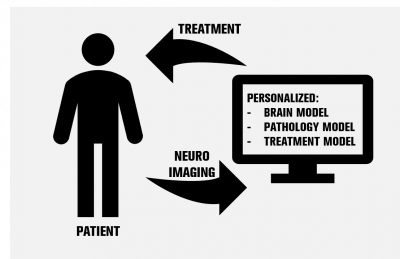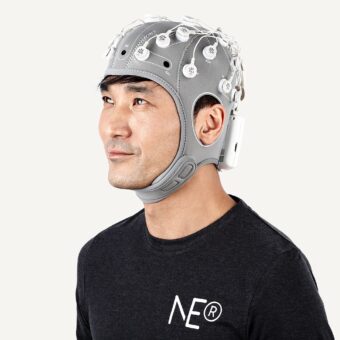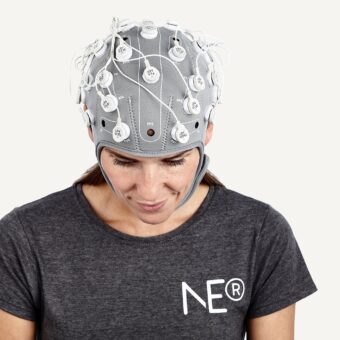What if doctors had a virtual version of their patients with their respective pathologies? They could test any possible treatment and know if it is going to work before even applying it. Personalization has become a standard practice in medical diagnosis and treatment since subject variability has a clear impact on the effectiveness of the therapy.
Computational models can help to diagnose and predict the outcomes of different treatments for different pathologies. Here we will focus on the personalization of neuromodulatory interventions in neuropsychiatry. We propose a model that encodes both anatomical and physiological features of one subject’s brain.
How can we model the brain?
The human brain is a dynamical system that can be defined as a network of networks, arranged in multiple scales and with different levels of complexity. Several theoretical and computational neuroscience studies have developed whole-brain network models to explore the structure-function relationship, leading to a newly developing field known as “network neuroscience” (Basset and Sporns, 2017).
In this framework, coupled mathematical differential equations can be used to describe the spatiotemporal dynamics of patterns of brain activity and traveling waves either at the level of one node or of larger-scale networks corresponding to multiple coupled nodes.
Traditionally, two main classes of models have been used to derive these differential equations: single neuron (e.g., Hodgkin-Huxley) or neural population models (e.g., Jansen and Rit). The former models are more detailed, but the state variables do not capture the activity recorded with techniques like Electroencephalography (EEG) or Magnetoencephalography (MEG). In contrast, population models such as Neural Mass Models (NMM) are more relevant when modeling brain activity at larger spatial and temporal scales. Despite providing a lower level of detail, they can represent the physiology of the brain: their parameters emerge from microscopically measurable quantities, such as dendritic time constants and mean excitatory/inhibitory postsynaptic potentials.

Depending on the complexity that we want to model, network nodes can represent either cortical patches or whole-brain areas (see review by Breakspear 2017). Accordingly, network edges are to describe appropriately the links between nodes. When modeling the whole brain the nodes usually represent cortical areas defined by a certain brain parcellation and edges the white matter tracts between them (Honey et al., 2009; Deco et al., 2018, Fig. 1a).
Representing the brain as a network is not the only way to model it. Most of the studies focused on the electric field distribution in electrical/magnetic stimulation of the brain represent it as a 3D mesh embedded in a whole head model, where each of the different tissues has its respective electrical conductivity (see Miranda et al. (2018) for a review of these types of models, Fig. 1b ).

How can we personalize such models?
Bansal et al. (2018) and Aerts et al. (2016) review recent research on personalized whole-brain network models. The former is related to the study of structure-function relationship in human brains and the second focuses on the impact of network lesions. Most of the studies cited in these reviews only use structural connectivity brain data derived from Diffusion Tensor Imaging (DTI) to personalize whole-brain models. For the 3D brain models, just subject-specific Magnetic Resonance Imaging (MRI) data is used to personalize them (Fig. 1).
Very few studies use physiological and anatomical data to personalize the model parameters, this is the case of Finger et al. (2016) and Cabral et al. (2014). Both of the studies optimized the coupling gain and the mean conduction velocity of a network of Kuramoto oscillators based on the correlation of functional connectivity (FC) profiles between simulated and real activity. They used DTI to connect the dynamical models and the FC extracted from the MEG/EEG to fit the model parameters, but they used averaged data from several subjects, not subject-specific.
Can we personalize a brain model with both anatomical and functional subject-specific data?
The answer is yes, and this is what we present as preliminary results in Sanchez-Todo (2018). In this study, we used the averaged DTI and subject-specific Magnetic Resonance Imaging (MRI) to connect Jansen and Rit NMMs. Then, with subject-specific resting-state EEG we extracted the FC profile and fit the model parameters. This is a first approach on how to create a personalized virtual brain model, or, as we call them “Hybrid Brain Models ” (HBM), since subject-specific EEG, MRI and DTI are used (Fig.2).

This study is a proof of concept suggesting that the proposed modeling approach using HBMs has the potential to represent meaningful features of EEG data. Nevertheless, future research needs to be done using a significantly larger number of participants and exploring different methodologies. For example, more complex NMM can be used to explore different frequency ranges such as the studies performed by Wendling and his colleges (Wendling et al. 2016).
References:
Aerts, H., Fias, W., Caeyenberghs, K., Marinazzo, D., 2016. Brain networks under attack: Robustness properties and the impact of lesions. Brain 139 (12), 3063–3083.
Bansal, K., Nakuci, J., Muldoon, S. F., 2018b. Personalized brain network models for assessing structure-function relationships, 1–13. URL https://arxiv.org/pdf/1802.00473.pdf
Bassett, D. S., Sporns, O., 2017. Network neuroscience. Nature Neuroscience 20 (3), 353–364.
Breakspear, M., 2017. Dynamic models of large-scale brain activity. Nature Neuroscience 20 (3), 340–352.
Cabral, J., Luckhoo, H., Woolrich, M., Joensson, M., Mohseni, H., Baker, A., Kringelbach, M. L., Deco, G., 2014. Exploring mechanisms of spontaneous functional connectivity in MEG: How delayed network interactions lead to structured amplitude envelopes of band-pass filtered oscillations. NeuroImage 90, 423–435. URL http://dx.doi.org/10.1016/j.neuroimage.2013.11.047
Deco, G., Cabral, J., Saenger, V. M., Boly, M., Tagliazucchi, E., Laufs, H., Someren, E. V., Jobst, B., Stevner, A., Kringelbach, M. L., 2018. Perturbation of whole-brain dynamics in silico reveals mechanistic differences between brain states. NeuroImage 169, 46 – 56. URL http://www.sciencedirect.com/science/article/pii/S1053811917310236
Finger, H., Bönstrup, M., Cheng, B., Messé, A., Hilgetag, C., Thomalla, G., Gerloff, C., K¨onig, P., 08 2016. Modeling of large-scale functional brain networks based on structural connectivity from dti: Comparison with eeg derived phase coupling networks and evaluation of alternative methods along the modeling path. PLOS Computational Biology 12 (8), 1–28. URL https://doi.org/10.1371/journal.pcbi.1005025
Honey, C. J., Sporns, O., Cammoun, L., Gigandet, X., Thiran, J. P., Meuli, R., Hagmann, P., 2009. Predicting human resting-state functional connectivity from structural connectivity. Proceedings of the National Academy of Sciences 106 (6), 2035–2040. URL http://www.pnas.org/content/106/6/2035
Miranda, P.C., Callejón-Leblic, M.A., Salvador, R., Ruffini, G., 2018. Realistic Modeling of Transcranial Current Stimulation: The Electric Field in the Brain. Curr. Opin. Biomed. Eng. https://doi.org/10.1016/j.cobme.2018.09.002
Sanchez-Todo, R., Salvador, R., Santarnecchi, E., Wendling, F., Deco, G., Ruffini, G., (2018) Personalization of hybrid brain models from neuroimaging and electrophysiology data, BioRxiv http://dx.doi.org/10.1101/461350 Wendling, F., Benquet, P., Bartolomei, F., Jirsa, V., 2016. Computational models of epileptiform activity. Journal of Neuroscience Methods 260, 233 – 251, methods and Models in Epilepsy Research. URL http://www.sciencedirect.com/science/article/pii/S0165027015001223



